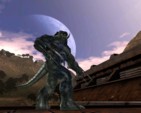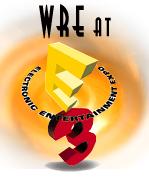Unreal II
Legend's Mike Verdu wants to make one thing exceedingly clear: You will not need a GeForce 3 to play Unreal II.
He's got reason to be frustrated. The stunning visuals of the game have
sparked a flurry of press reports that in order to run the next
installment in this action series, you'll need nVidia's top of the line
card. And even though the game won't see store shelves for at least a
year (probably more), that's still going to be more than most gamers
are willing - or able - to pay.
Now granted, if you do happen to have a
GeForce 3 in your machine, you're going to see a little more than your
GeForce 2-owning friend, but hey...that's their tough luck! Either way,
both of you are guaranteed a beautiful looking game that's shaping up
to have a hefty amount of actual gameplay as well.
 The original Unreal had a story, but not the best of ones. Unreal Tournament abandoned story altogether for a zesty testosterone/adrenaline cocktail. Unreal II,
though, might just engage you mentally as well as emotionally (if
shouting insults at your onscreen opponents can be considered an
emotion). The original Unreal had a story, but not the best of ones. Unreal Tournament abandoned story altogether for a zesty testosterone/adrenaline cocktail. Unreal II,
though, might just engage you mentally as well as emotionally (if
shouting insults at your onscreen opponents can be considered an
emotion).
Rather than the prisoner you portrayed in
the first game, you're now the "lone representative of law on the high
frontier," says Verdu. You command the Atlantis, a ship with a
three-person crew protecting miners, technicians, archaeologists and
other civilian workers. 69 days out from your home base, a galactic war
breaks out - and you've got to find out why and do what you can to stop
it.
You'll face multiple enemies - six all
totaled, including an robotic AI-driven race. Along the way, you'll
have multiple mercenary and military groups to assist and resist you as
well. Guiding you through the levels will be Aida, a member of your
crew and the requisite high-pixel hottie with cleavage galore. A former
military office, she has an excellent intelligence network and keeps
you up to date with important events in the game.
For the record, yes, Aida is as stunning
on screen as she is in the concept art. Thankfully, from what we saw,
she's also an intelligent, key part of the game. While she mainly
serves as the voice in your ear or on the monitor screen while you save
the universe, you'll also have regular chances to interact with her
when you're aboard the Atlantis.
The game actually brought up memories of Wing Commander III
in that once you complete a mission, you head back to the ship for the
story to advance. As you communicate with your shipmates, you'll have
several possible responses to their comments, each resulting in a
different reaction. Thankfully, all of these scenes are handled with
the in-game engine, rather than cutscenes or full motion video.
 Fifteen
weapons will be at your disposal as you go on missions. Five you can
probably guess (rocket launcher, grenade, pistol, machine gun, sniper
rifle). Most of the other 10 are being kept a mystery for now, but
Legend's promising a unique arsenal. Fifteen
weapons will be at your disposal as you go on missions. Five you can
probably guess (rocket launcher, grenade, pistol, machine gun, sniper
rifle). Most of the other 10 are being kept a mystery for now, but
Legend's promising a unique arsenal.
If the flame-thrower they showed in a
closed door session at E3 this year is an indication of the magnitude
of those other weapons, you've got nothing to worry about. We've all
used flamethrowers before. And yeah, they're pretty cool weapons to
wield, but you've never seen anything like what Unreal II has
in store for you. The flame has a life of its own, shooting out and
engulfing an area. If you see an enemy with one of these nearby, run.
Fast.
Keep an eye on your surroundings as you discharge your weapon, too. While Unreal II's environment isn't quite as destructible as Red Faction's, you can do a lot of damage to it, should the mood strike you.
Part of the reason behind that is the
game's almost insane poly count. Verdu and senior level designer Scott
Dalton say this game will have 100 times the polygon count of Unreal Tournament.
That's an extraordinary jump, but it's hard to argue after seeing some
of the levels. The earth-like level shown in previous demos is
startlingly realistic, but if you want to see some serious detail, wait
until you enter one of the alien bases. Looking more like a Geiger
painting than a part of a PC game, these hives boast a phenomenal
amount of detail.
Back to gameplay, Legend's taking care to right some long-standing wrongs in the action gaming world. In Unreal II,
just because you vanquish an enemy and take its weapon, doesn't mean
that you know what to do with it. Before you can add that firepower to
your own arsenal, you'll need to take it back to the Atlantis and have
your team examine it. It will be at least one mission before you're
able to use it.
You'll find yourself relying on your teammates a fair amount in Unreal II.
There are, in fact, several team-based missions, pairing you with a
squad of mercs or marines to fight off hostiles. But even outside of
combat conditions, your interaction with NPCs will shape the game world
with you. On board the Atlantis (and presumably in other environments
as well), the head and eyes of the people you're talking to track you
as you move during the conversation. And you'll be able to judge the
mood of your shipmates and other allies by simply looking at them. If
they're upset with you, you'll be greeted with a scowl warning you away
- or at least of a cold reception if you start a conversation with them.
 A
good way to piss off your friends is to interrupt their conversations.
The game allows for you to break into other people's discussions in
order to get information - just as other will interrupt you. Do so and
you'll probably learn what you want to know, but the people you
interrupted will remember your rudeness and hold it against you. A
good way to piss off your friends is to interrupt their conversations.
The game allows for you to break into other people's discussions in
order to get information - just as other will interrupt you. Do so and
you'll probably learn what you want to know, but the people you
interrupted will remember your rudeness and hold it against you.
The pace of the action is mixed, sometimes offering the frenetic assault gameplay of UT,
other times offering a more contemplative pace. In other words, expect
to face several rooms full of aliens, but in between those encounters
you'll have to handle some rescue and reconnaissance missions.
Don't look for the enemies you face to be
pushovers, either. The enemy AI, even in this early stage, is very,
very sharp. Opposing forces duck behind walls when you're firing at
them or crouch behind windowsills waiting for you to have to reload.
It's more than balls-to-the-wall action - and that, in itself, is
reason to cheer.
While Verdu and Dalton emphasized the single player elements in the demo we attended, they made it clear that Unreal II
will have a vibrant multiplayer component. In addition to the default
CTF and Deathmatch modes, the game will also feature an expanded
multiplayer mode that allows you to build replicators to control
various weapons and ammo. That's right: Unreal's showing some real-time strategy elements. Stay tuned for more details on those in the coming months.
We're still a long way out for Unreal II. But if the quality level of the game keeps building toward what we saw at E3, this one's gonna be well worth the wait.
Screen shot gallery
| 




